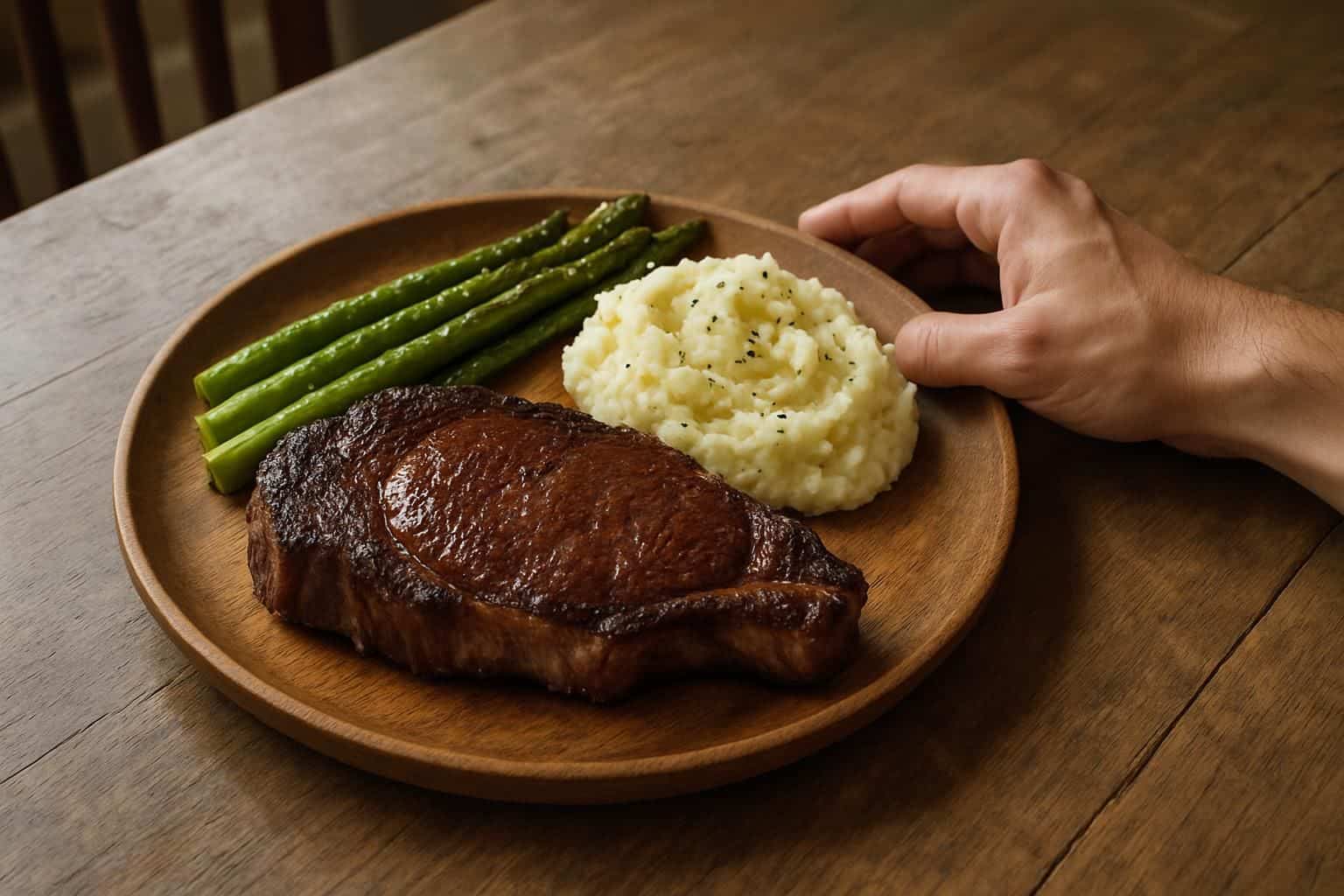Are you tired of eating the same boring meals every day on your carnivore diet? Carnivore diet recipes rely solely on animal products, leaving out plants completely. This blog post gives you tasty ideas to spice up breakfast, lunch, and dinner, making it easier than ever to stick with your meal plan.
Keep reading for 15 mouthwatering recipes that you’ll love to cook and eat!
Key Takeaways
The carnivore diet centers around eating animal-based foods only—zero vegetables, fruits, or grains allowed.
Breakfast can be scrambled eggs mixed with rich bone marrow, savory bacon with ground beef bowls, or even creamy egg pudding if you’re craving something sweet.
For lunch, try juicy hanger steak marinated with herbs, sizzling blackened ribeye, or chicken thighs crisped perfectly in tasty animal fats.
Dinner dishes include tender beef brisket cooked low and slow, pork belly with a delicious crispy crust, lamb rack topped with seasoned herb butter, or flaky Mediterranean-style baked cod.
Quick snack ideas—like homemade beef jerky or seasoned meatballs—keep hunger away and make it easy to stick to this meat-only eating routine.
Table of Contents
Easy and Tasty Breakfast Options for the Carnivore Diet

Breakfast sets the tone for your entire day on the carnivore diet. Start your morning with protein-rich meals that keep you full and focused without any carbs.
How do I make scrambled eggs with bone marrow?
Scrambled eggs with bone marrow offer a delicious, nutritious option for anyone following the carnivore diet. This easy meal blends protein-rich eggs and nourishing marrow fats for an energizing start to your day.
- Visit your nearest butcher shop or grocery meat counter and select fresh marrow bones.
- Warm a skillet on medium heat and melt a generous slice of butter.
- Using a small spoon, scoop out the soft marrow carefully.
- Crack three or four eggs into a bowl, then whisk them thoroughly for a consistent texture.
- Season the beaten eggs lightly with salt.
- Add marrow gently into the hot skillet until it begins melting.
- Pour eggs directly into the skillet, mixing gently with a spatula or wooden spoon.
- Cook slowly on lower heat, preventing eggs from getting firm too fast.
- Stir occasionally until soft curds form, leaving the eggs slightly moist.
- Pull eggs from heat before fully set, since they’ll firm up a bit more afterward.
- Serve immediately for ideal taste and a fluffy consistency.
- Pair your eggs with cooked bacon or grilled steak to create a hearty carnivore meal.
- Keep any leftover marrow covered in the fridge to use later.
Now here’s another satisfying breakfast idea that’ll keep your carnivore menu tasty.
What is a simple recipe for a carnivore breakfast bowl?
The Carnivore Breakfast Bowl is a fast, tasty meal that gives you a powerful protein boost with everyday items right in your kitchen. It cooks up in just 15 minutes, keeping hunger away for hours, without those pesky carb crashes.
- Take out 4 slices of bacon, 12 ounces ground beef, and 2 pastured eggs.
- Warm up a large skillet on medium heat, then fry bacon until crispy—about 5 minutes.
- Set aside crispy bacon but keep the flavorful bacon grease right there in the pan.
- Toss ground beef into the bacon grease and break it apart with a wooden spoon.
- Cook beef around 5 minutes, stirring often, until fully browned.
- Move cooked beef to one side of your pan, then crack eggs into the empty area.
- Let eggs cook to your preferred doneness; runny yolks taste great mixed in with the meat.
- Crumble up bacon slices and sprinkle them over your cooked beef and eggs.
- Serve immediately in your favorite bowl, getting the maximum flavor while still hot.
- Enjoy this satisfying high-protein breakfast to stay energized longer without sugar spikes.
- Save any extras in a sealed container—though honestly, it tastes best right off the stove.
- Experiment with other meats—try steak or organ meat cuts—to boost nutrition in your low-carb breakfast.
How can I prepare carnivore egg pudding?
Carnivore egg pudding is a tasty, creamy treat perfect for your meat-based diet—plus, it’s quick and easy to prepare. This dessert only uses animal ingredients, keeping you in ketosis while enjoying comfort food.
- Get your three key ingredients ready: 5 large eggs, 4 oz half-and-half milk, and 1 tbsp butter.
- Preheat your oven to 350°F before starting.
- Crack eggs into a mixing bowl, and whisk them until frothy and smooth.
- Stir in the half-and-half until completely mixed with the eggs.
- Melt the butter gently in a microwave or on the stove until fully liquid.
- Pour melted butter into your egg mixture, mixing well.
- Sweeten it up, if you want, by adding 2½ tbsp of a carnivore-friendly sweetener.
- Stir in 1 tsp vanilla extract—it adds great flavor without carbs.
- Carefully pour the pudding mix into a baking dish or portion it into individual ramekins.
- Bake for about 30-35 minutes, until the pudding sets but still slightly jiggles.
- Test for doneness with a knife in the center—it should come out mostly clean.
- Cool your pudding for 10 minutes after removing from the oven for ideal texture.
- Keep remaining pudding in your fridge for up to three days for easy snacks later.
- If you’re out of half-and-half, mix 2 oz heavy cream with 2 oz water instead—it works perfectly.
- Serve it warm or cool, whichever way you like best.
I make this pudding every week since starting my carnivore routine—it really helps manage my sweet cravings without affecting ketosis. If you could use some extra motivation or fresh meal ideas, check out resources like IPTV Canada. They offer helpful health and nutrition guidance, along with plenty of tasty recipes to support your carnivore lifestyle. Now, let’s check out some easy and delicious lunch ideas to keep you full during busy days.
Delicious Carnivore Lunch Recipes

Lunch is the perfect time to enjoy rich, flavorful meat dishes that keep you full and focused. These lunch recipes bring bold flavors to your plate while sticking to pure carnivore principles.
How do I grill herb-marinated hanger steak?
Herb-marinated hanger steak is a tasty, protein-rich meal—perfect if you’re eating carnivore style. This easy recipe relies on basic herbs to highlight the steak’s natural, juicy flavor.
- Start by picking a fresh hanger steak from your local butcher; fresh meat gives better results.
- Create your herb rub by mixing sea salt, dried rosemary, and dried thyme together in a small bowl.
- Pat your steak completely dry using paper towels.
- Rub your herb mixture evenly over the steak, pressing lightly so the seasoning sticks.
- Let it sit out about 30 minutes at room temperature—this helps flavors absorb better into the meat.
- Preheat the grill to high heat, about 450°F, for the perfect tasty sear.
- Put the steak directly onto the heated grill grates to create a flavorful crust.
- Grill 4-5 minutes per side if you prefer a medium-rare finish.
- Flip your steak only once with tongs during cooking, sealing in juices for flavorful, tender bites.
- Check cooking progress using a meat thermometer—130°F is ideal for medium-rare steak.
- Transfer steak from the grill onto a clean cutting board.
- Allow it to rest uncovered for 5-10 minutes, helping juices redistribute evenly inside the meat.
- Slice your hanger steak thinly against the grain to make every bite tender.
- Top your steak servings with a generous pat of grass-fed butter for added fats and richness.
- Pair steak with other animal-based favorites, such as eggs or organ meats, for a fully satisfying carnivore dining experience.
What is the best way to cook blackened rib eye?
Blackened ribeye adds delicious bold taste to your meat-focused meals—and it’s really easy to prepare. I’ve found this cooking style makes a crispy, flavorful outside while keeping the inside juicy and tender.
- Take a 12-ounce ribeye steak and let it sit at room temperature to cook evenly.
- Combine 1 tablespoon sea salt, 1 teaspoon black pepper, and spices you prefer like paprika or garlic powder.
- Pat the steak dry with paper towels, helping spices stick well.
- Sprinkle and press the spice rub onto both sides of the steak, making a full, even coating.
- Heat your cast-iron skillet until it’s smoking hot—that gives you a nice crust.
- Place the steak carefully in the pan and sear it without moving, for 3 to 4 minutes.
- Flip the steak just once, searing the other side another 3 to 4 minutes for medium-rare.
- Add about 2 tablespoons of butter to the pan during the last minute of cooking.
- Spoon bubbling butter over the steak to add more flavor as it finishes cooking.
- Check your steak with a meat thermometer—130 to 135°F is ideal for medium-rare perfection.
- Let the cooked steak rest for 5 minutes, helping the juices stay inside.
- Top with a bit more butter, if you’d like extra richness before serving.
Now, let’s turn to crispy chicken thighs—a tasty, low-carb lunch option you’ll really enjoy.
How can I make crispy chicken thighs?
Crispy chicken thighs are an easy, protein-filled meal ideal for any carnivore diet. Bone-in thighs offer more flavor and stay juicy during cooking.
- Prepare 4 chicken thighs with the bone in for optimal taste.
- Thoroughly dry each thigh using paper towels to remove extra moisture.
- Generously sprinkle each piece with salt and a dash of oregano for enhanced flavor.
- Heat duck fat or tallow in a cast-iron skillet until it gently shimmers.
- Carefully place thighs in the pan, skin-side down, without moving them for 7-8 minutes.
- Flip each thigh over and cook for an additional 7 minutes, until the internal temperature reaches 165°F.
- Air fryer enthusiasts can cook seasoned thighs at 356°F for exactly 14 minutes.
- Before cooking, gently press down each thigh for even cooking and crispier skin.
- Let thighs rest for around 5 minutes before serving, sealing in the juices.
- For picky family members, pair this dish with these dinner ideas for picky eaters.
- You can store any remaining thighs in your fridge for easy high-protein snacks within the next 3 days.
- Experiment freely with new spice mixes or a hint of chili paste for variety, without straying from your low-carb approach.
Hearty Dinner Meals for Carnivore Diet Followers

Dive into hearty dinner meals that will keep your carnivore diet exciting and your taste buds happy – from juicy slow-cooked brisket to crispy pork belly that melts in your mouth.
How do I slow-cook beef brisket?
Preparing a slow-cooked beef brisket makes a delicious, tender meal ideal for your carnivore diet. This method turns a simple cut of beef into flavorful, fork-tender bites—perfect for satisfying your protein needs. Just follow these easy steps:
- Choose a brisket weighing between 3 and 4 pounds, ensuring plenty of marbling for juiciness and taste.
- Thoroughly pat the meat dry using paper towels to improve browning.
- In a small bowl, combine 2 tablespoons of sea salt and 1 tablespoon of black pepper.
- Generously rub this seasoning blend onto all sides of the brisket, gently pressing it into the meat fibers.
- Melt 2 tablespoons of beef fat (or tallow) in a Dutch oven on medium-high heat.
- Cook each side of the brisket about 3 minutes, searing the outside until golden-brown crust forms.
- While browning, set your oven temperature to 275°F.
- After searing, tightly secure the Dutch oven’s lid to keep moisture inside.
- Carefully move the covered pot into your heated oven.
- Roast the brisket slowly, around 3 to 4 hours, until you can effortlessly pull the meat apart with a fork.
- Allow the cooked brisket to sit out uncovered for about 15 minutes before slicing across the grain.
- Spoon the delicious juices left in the pot over sliced servings for added moisture and taste.
- To preserve leftovers, seal them tightly in a container and refrigerate for up to 4 days.
- Pair leftover brisket slices with eggs the next day for a tasty, protein-packed breakfast.
- Experiment with cooking fats—duck fat or pork lard can add interesting variations in flavor.
What is the method for pan-seared pork belly?
After you’ve perfected beef brisket, pork belly is your next delicious upgrade. Pan-searing gives it a crispy, golden outside, while the inside stays juicy and tender.
Follow these quick steps for amazing pork belly:
- Remove the skin from a 1-pound slab of pork belly—it cooks easier and tastes better this way.
- Season generously with 1 tablespoon sea salt and 1 teaspoon black pepper to bring out the flavor.
- Slice it into 1-inch thick pieces for even cooking all around.
- Heat animal-based fats—like tallow or lard—in a heavy pan over medium heat until you see it shimmer slightly.
- Carefully add pork belly slices, spacing them evenly—no overcrowding here.
- Sear each side 3–4 minutes, forming a nice golden-brown crust.
- Turn down the heat slightly after searing, and cook another 5 minutes to render the fat deliciously.
- The pork belly’s fat slowly melts, naturally basting itself and boosting flavor.
- Flip your pork belly pieces using tongs, avoiding forks that can poke and drain out tasty juices.
- Let meat rest 3 minutes before serving—it stays juicier this way.
- Serve alongside eggs for an easy, protein-packed meal.
- Store extras in the fridge up to 3 days for quick, tasty snacks anytime.
- Save leftover melted fat—it’s a tasty cooking fat for your next carnivore-friendly meal.
- This recipe packs plenty of protein and saturated fat, ideal for your low-carb eating plan.
How do I prepare rack of lamb with herb butter?
Rack of lamb looks impressive on the table, yet it’s surprisingly easy to prepare. Tender and juicy, it tastes amazing topped with savory herb butter that’s rich with flavor.
Here’s a quick and easy guide:
- Choose a fresh rack of lamb from your butcher or local grocery.
- Pat the meat dry gently, using paper towels—this helps it brown nicely.
- Season generously on every side with salt and freshly ground pepper.
- Heat a cast-iron skillet, adding animal fat, until it starts shimmering.
- Sear the lamb rack about two minutes per side till golden-brown crust forms.
- Blend softened butter with finely chopped rosemary, thyme, and garlic.
- Spread mustard evenly onto the lamb and press the garlic and rosemary firmly onto the surface.
- Place the seasoned meat in your roasting pan, with the bones pointing upward.
- Roast the rack at 400°F, for about 15 to 20 minutes, for perfect medium-rare meat.
- Use a cooking thermometer to make sure it hits precisely 125°F inside—ideal temperature for juicy medium-rare.
- Let it sit outside the oven, loosely covered, for 10 minutes to seal in juices.
- Spoon a generous tablespoon of herb butter over the warm meat right before serving.
- Slice neatly between each rib bone, serving individual chops.
- Serve alongside tasty, low-carb side dishes—perfect for a hearty carnivore-friendly meal.
- Store leftovers covered in the fridge—they’ll stay tasty for three days.
How can I make Mediterranean baked cod?
Time to level up your carnivore-friendly seafood recipes with this easy Mediterranean baked cod: fresh, tasty, and ready within minutes.
- Get fresh cod fillets at your nearby grocery store or fish market.
- Pat each fillet dry using paper towels—dry fish browns much nicer.
- Generously season the cod on both sides with salt and freshly ground black pepper.
- Lay the fillets in a baking dish covered with parchment paper.
- Drizzle olive oil or melted butter over the top, giving it rich flavor and keeping it moist.
- Sprinkle dried herbs—oregano, thyme, and a hint of rosemary—for an inviting Mediterranean touch.
- Top each piece with fresh lemon slices, adding a nice burst of citrus freshness.
- Bake at 400°F for around 12-15 minutes, just until the cod flakes easily with a fork.
- Check that it’s cooked through: perfectly done cod turns opaque and reaches 145°F internally.
- Serve immediately with warm, extra butter on the side to add even more flavor.
- Packed with protein, this dish easily fits your low-carb lifestyle and delivers valuable omega-3 fats.
- Cod also offers beneficial vitamins and minerals that complement a meat-focused diet.
- For a tasty switch-up, swap in other white fish varieties—try haddock or halibut.
- Pop leftovers into an airtight container and keep in the fridge for up to two days.
- This quick seafood recipe helps you stick to your weight-loss plan without compromising delicious meals.
Quick and Simple Carnivore Snack Ideas

When hunger strikes between meals, you need fast and tasty options that stick to your meat-only plan. These grab-and-go protein bites will keep you full and focused without breaking your carnivore rules.
What is an easy recipe for beef jerky?
Homemade beef jerky is an ideal high-protein snack, perfect for a carnivore diet. Preparing it yourself is straightforward, using fresh cuts and simple seasonings.
- Select around 2 pounds of lean beef, such as top round, eye of round, or flank steak.
- Slice the meat into thin strips, roughly 1/8 to 1/4 inch thick, going against the grain for better texture.
- Combine sea salt, black pepper, and carnivore-approved spices like garlic powder in a bowl to create your simple marinade.
- Place the meat slices into the marinade, then refrigerate them for at least 4 hours—though overnight gives the best flavor results.
- After marinating, gently pat dry each strip with paper towels, then arrange them evenly on dehydrator trays or oven racks.
- Dry the beef in a dehydrator set to 160°F for approximately 4-6 hours, until each piece is firm yet pliable—flexing without cracking.
- Once finished, keep your jerky fresh by storing it in airtight containers or sealed bags in a cool, dry place for up to two weeks.
- Try other protein options like turkey or venison to add variety and new flavors to your snacks.
- Make jerky regularly as part of weekly meal prep, keeping healthy, ready-to-eat snacks available on busy days.
- Snack on your homemade jerky to support weight-loss goals—it offers pure protein and essential nutrients with zero carbs.
How do I make carnivore meatballs?
Let’s move beyond beef jerky and explore another delicious, protein-rich snack that’s perfect for your carnivore diet: carnivore meatballs. Quick to prep, easy to enjoy on the go, these meatballs deliver tons of flavor and nutrients—without any plant ingredients.
- Combine 2 pounds of ground pork with 1 pound of ground beef in a large bowl, achieving the ideal 2:1 ratio for optimal flavor.
- Sprinkle in sea salt, plus carnivore-approved spices like black pepper or garlic powder, according to taste.
- Gently mix the ingredients by hand until evenly combined—avoid mixing too much, as this can produce tougher meatballs.
- Shape the meat blend into about 36 meatballs, each roughly 1.5 inches round.
- Arrange these evenly spaced on a baking sheet lined with parchment paper.
- Bake them at 400°F for 20–24 minutes, or until a meat thermometer reads 165°F inside.
- Preparation takes only about 10 minutes before cooking, ideal for busy schedules.
- Four meatballs offer around 360 calories, 33 grams protein, and 24 grams fat—a great nutrient-packed option for high-protein eating.
- Let the meatballs cool entirely before you store them.
- Keep them refrigerated in sealed containers for quick snacks and meals, lasting up to 5 days.
- For extended storage, vacuum-seal and freeze—good for up to 3 months.
- Meatballs are tasty eaten alone or alongside other carnivore-approved foods.
Essential Tips for Successful Carnivore Diet Cooking

Mastering the carnivore diet needs smart cooking tricks to keep meals tasty and healthy. Learn how to pick the best cuts of meat, use organ meats for extra nutrients, and cook with animal fats for better flavor in our complete guide.
Why should I use a variety of meats and cuts?
Switching up your meat choices helps prevent diet boredom and keeps your carnivore meal plan interesting. Beef liver offers unique nutrients, different from what you’d find in chicken thighs or salmon steaks.
Your body needs this wide range of proteins and fats to function at its best. Many women enjoy rotating meals—maybe pork chops one night, lamb ribs another, and cod fillets later in the week.
This method keeps meal prep fun and taste buds satisfied.
Exploring various cuts of meat also makes budget-friendly eating easier. Ribeye steaks taste amazing but tend to get pricey, while chuck roast and chicken drumsticks are much easier on your wallet.
These affordable choices provide solid protein without the hefty price tag. Eating this way lets your body receive balanced nutrition, while your credit card takes a well-deserved breather.
How do organ meats add nutrients to my diet?
Organ meats deliver a nutritional boost muscle meats can’t beat. Liver, for example, is packed with vitamins A and B12—perfect for radiant skin and all-day energy. Heart meat offers CoQ10, a nutrient that strengthens cells, plus essential fatty acids your body needs.
Kidneys also deserve a spot on your plate, giving you selenium and omega-3 fats, ideal for calming inflammation and protecting your heart health.
Eating meat “nose-to-tail” rounds out your protein-focused diet with richer nutrition. Many women overlook organ meats, yet these foods can fill gaps often left by low-carb eating.
One serving of liver alone has more vitamins than multiple portions of traditional muscle meat. To ease into it, blend tiny amounts of ground organ meat into burgers or meatballs, masking the taste while still enjoying the benefits.
Adding organ meats can help trim your BMI and stabilize blood sugar—whole foods like these naturally deliver nutrition your body loves.
What are the benefits of cooking in animal-based fats?
Adding organ meats to your diet can greatly increase essential nutrients, while cooking with animal fats truly upgrades carnivore meals. Animal-based fats—like butter, lard, and tallow—offer much more than cooking utility.
They deliver a delicious richness to any meal and pack in plenty of energy, offering a great boost.
Many women who follow carnivore diets notice faster weight loss by using these healthy fats. I made the switch to beef tallow about a year ago, and immediately my meals tasted richer and kept hunger away much longer.
Plus, animal fats naturally ease inflammation, soothing joint pain and giving your skin a healthier glow. Choosing just one simple fat can make meal prep quicker and easier—especially on busy workdays or hectic weekends.
Animal fats remain stable even at high cooking temperatures, unlike plant-based oils, which break down and create unwanted toxins. This stability makes them ideal for searing juicy steaks or quickly frying eggs—a perfect match for your tasty, low-carb eating style.
How Will Carnivore Diet Trends Evolve in 2025?
The carnivore diet will become very popular in 2025, as many people shift to low-carb, high-protein eating. Social media will buzz with personal stories of clearer skin, sharper focus, and increased energy levels from following this diet.
Numerous women will share how the carnivore lifestyle has helped ease their autoimmune symptoms—especially appealing for those facing persistent health struggles. Celebrity endorsements will boost this trend even more, bringing it to larger audiences.
Supportive online communities will offer newcomers helpful tips, meal ideas, and encouragement along the way.
Food brands will quickly pick up on this growing trend, offering convenient products aimed at carnivore dieters. We’ll see an increase in meal delivery options, pre-packed organ meats, and seasoning blends specifically labeled as carnivore-friendly in grocery stores.
The diet’s appeal will center more on nutrient-packed, sustainably sourced meats, rather than simply weight loss goals. Many women who move to lose weight may discover that this eating style aligns better with their active routines than traditional low-fat diets.
People Also Ask
What is a carnivore diet and how does it compare to other low-carb diets?
A carnivore diet means eating only animal products—no fruits, veggies, or grains allowed. This makes it stricter than keto or regular low-carb diets, which usually let you enjoy some plant foods. While balanced diets typically include whole grains and vegetables, carnivore diets skip plants altogether. It’s often seen as a trendy diet that goes against typical nutrition advice.
Are there health risks with following carnivore diet recipes?
Yes, you could face health issues by leaving out plants. Cutting fruits and vegetables removes essential nutrients like fiber and folate from your meals. Research ties overly high protein intakes to higher chances of heart disease, high blood pressure, and type 2 diabetes. Before trying such a limited diet, it’s wise to chat with a registered dietitian first.
What types of meat work best for carnivore diet recipes?
Fattier cuts of beef, pork, and lamb usually form the foundation of carnivore recipes. Fish rich in omega-3, such as salmon, also makes tasty, healthy choices. Organ meats like liver or kidneys can offer nutrients missing in traditional muscle meats—plus, they add interesting textures and flavors.
Can I use sauces in carnivore diet cooking?
Yes, you can use sauces made from animal fats or simple butter-based sauces. Store-bought sauces often have sugars or plant ingredients, so they usually don’t fit into this diet. Many carnivore cooks use homemade sauces created from pan drippings and fats as tasty alternatives.
How can I make carnivore diet meals more interesting?
Shake things up by grilling, smoking your meat, or slow-cooking tougher cuts for added flavor. Eggs can be great appetizers or tasty sides with your meal. Switching up the animal sources and trying new cuts can also keep meals tasty and exciting.
Will a carnivore diet help with obesity and weight loss?
Many people lose weight and improve their body mass index on a carnivore diet, probably because junk foods are totally cut out, which naturally lowers calorie intake. Still, research on the diet’s long-term effects is limited, and results vary widely from person to person.
